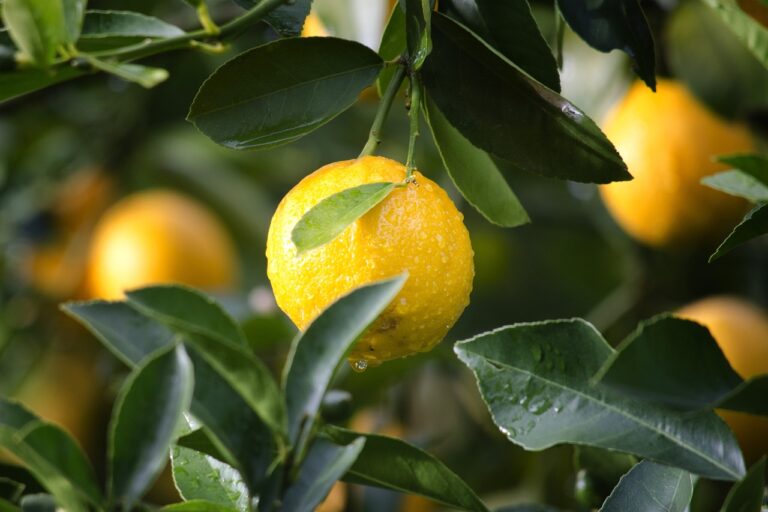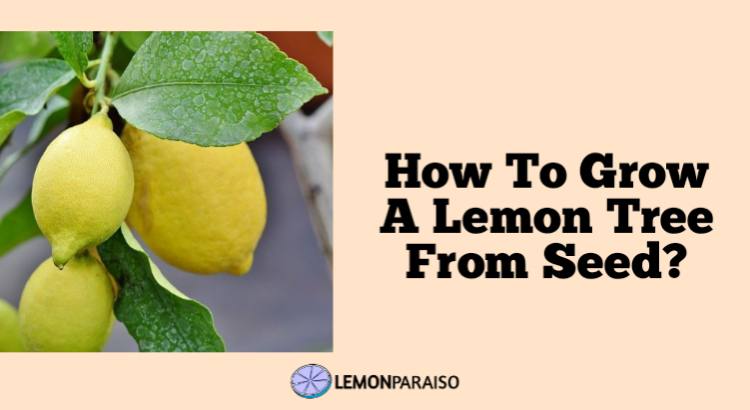Can Lemon Trees Grow In Pots?

Lemon trees are a popular choice among gardening enthusiasts who want to enjoy the beauty, fragrance, and delicious fruit of these versatile plants.
Growing lemon trees in pots offers numerous advantages, such as greater control over the tree’s environment, the ability to move the tree indoors during extreme weather, and the opportunity to cultivate lemon trees in limited spaces or colder climates.
Can Lemon Trees Grow In Pots?
Yes, lemon trees can indeed grow in pots, making them an ideal choice for gardeners with limited space or those who live in colder climates. Growing lemon trees in pots allows for greater control over the tree’s environment and makes it easier to move the tree indoors during extreme weather conditions.
Dwarf and semi-dwarf lemon tree varieties are particularly well-suited for container cultivation, as they typically have smaller root systems and more manageable sizes. When selecting a lemon tree for pot cultivation, look for varieties like Improved Meyer, Ponderosa, or Lisbon, which are known to thrive in containers.
What Temperature Range Is Suitable For Lemon Trees In Pots?
Lemon trees in pots thrive in temperature ranges between 65-85°F during the day and 55-65°F at night. Although lemon trees can tolerate brief periods of colder temperatures, they are sensitive to frost and prolonged exposure to temperatures below freezing can be detrimental to their health.
Potted lemon trees can be moved indoors or to a protected location when temperatures drop below 32°F to prevent frost damage. On the other hand, extreme heat can also cause stress to the tree, so it’s essential to provide adequate shade and water during periods of intense heat.
Monitoring and maintaining the appropriate temperature range for your potted lemon tree is crucial for its health and productivity.
How Big Of A Pot Do I Need For A Lemon Tree?
The size of the pot required for a lemon tree depends on the tree’s variety and its mature size. Generally, a container with a minimum diameter of 18-24 inches and a depth of at least 18 inches is suitable for most dwarf and semi-dwarf lemon tree varieties.
As the tree grows, you may need to repot it into a larger container to accommodate its expanding root system. A pot with drainage holes is essential to prevent waterlogging, which can lead to root rot and other health issues.
Ideally, the pot should be made of a durable material like ceramic, resin, or high-quality plastic to withstand temperature fluctuations and provide insulation for the tree’s roots. A heavy pot will also help prevent the tree from toppling over in windy conditions.
What Type Of Soil Is Best For Lemon Trees In Pots?
Lemon trees in pots require well-draining, slightly acidic soil with a pH between 6.0 and 6.5 for optimal growth. A high-quality, citrus-specific potting mix is ideal, as it contains the necessary nutrients and allows for proper water retention and drainage.
You can also create your own soil mix by combining equal parts of peat moss, perlite or coarse sand, and compost or aged manure. This mixture will provide the necessary nutrients, aeration, and drainage to support a healthy lemon tree.
Additionally, adding a few inches of mulch on top of the soil can help regulate moisture levels and protect the tree’s roots from temperature extremes. Be sure to leave a gap between the mulch and the tree trunk to prevent rot.
How Often Should I Water My Lemon Tree In A Pot?
The frequency of watering for a potted lemon tree depends on factors such as the size of the pot, the type of soil, and environmental conditions like temperature and humidity. Generally, you should water your lemon tree when the top 1-2 inches of soil feels dry to the touch.
This usually translates to watering every 7-10 days, although it might be more frequent during hot, dry periods or less frequent during cooler months. It’s important to water the tree deeply, allowing the water to saturate the root zone, and then allow the soil to dry slightly before watering again.
Avoid overwatering, as this can lead to root rot and other health issues. Proper drainage is essential to prevent waterlogging, so ensure your pot has drainage holes and consider placing a saucer beneath the pot to catch excess water.
How Much Sunlight Does A Lemon Tree In A Pot Need?
A lemon tree in a pot requires a minimum of 6-8 hours of direct sunlight per day to grow and produce fruit effectively. If grown indoors, placing the tree near a south-facing window will provide the most sunlight.
Supplemental lighting, such as grow lights or fluorescent bulbs, may be necessary if the tree does not receive adequate natural light, particularly during winter months when daylight hours are shorter.
For outdoor potted lemon trees, choose a sunny location that is protected from strong winds and harsh weather conditions. Regularly rotating the pot will ensure even sunlight exposure and promote balanced growth. Providing a lemon tree with sufficient sunlight is crucial for its overall health, as well as its ability to produce fruit.
How Do I Fertilize My Lemon Tree In A Pot?
Fertilizing a lemon tree in a pot is essential to support its growth and fruit production. Use a slow-release, citrus-specific fertilizer with balanced amounts of nitrogen, phosphorus, and potassium, as well as essential micronutrients like iron, zinc, and magnesium.
Follow the manufacturer’s instructions for the appropriate amount and frequency of application, usually every 2-3 months during the growing season. Alternatively, you can use a water-soluble fertilizer at half strength, applied more frequently, every 4-6 weeks.
Be sure to water the tree thoroughly before and after applying fertilizer to prevent root burn and ensure even nutrient distribution. Regularly monitoring your lemon tree’s health and adjusting fertilization practices as needed can help maintain a healthy and productive potted lemon tree.
How Long Does It Take For A Lemon Tree To Bear Fruit In A Pot?
The time it takes for a lemon tree to bear fruit in a pot can vary depending on the variety, age of the tree, and growing conditions. Generally, a grafted lemon tree can start producing fruit within 2-3 years after planting, while a tree grown from seed may take 5-7 years or longer to bear fruit.
Proper care, including sufficient sunlight, watering, fertilization, and pruning, is crucial for a potted lemon tree to produce fruit.
Additionally, choosing a self-pollinating variety, such as the Improved Meyer lemon, is beneficial when growing in a pot, as it does not require cross-pollination to produce fruit. Patience and attention to the tree’s needs are essential for a successful fruit-bearing lemon tree in a pot.
What Are The Common Problems Faced While Growing Lemon Trees In Pots?
Several common problems can arise while growing lemon trees in pots, including:
- Overwatering or poor drainage: Excessive moisture in the soil can lead to root rot and other health issues. Ensure the pot has drainage holes and allow the soil to dry slightly between waterings.
- Insufficient sunlight: Lemon trees require a minimum of 6-8 hours of direct sunlight per day. Place the tree in a sunny location or supplement with grow lights if necessary.
- Nutrient deficiencies: Use a citrus-specific fertilizer to provide essential nutrients and prevent deficiencies that can cause leaf yellowing, poor growth, and reduced fruit production.
- Pests: Common pests like aphids, scale insects, and spider mites can infest lemon trees. Monitor your tree regularly and treat pests promptly with insecticidal soap or neem oil.
- Disease: Fungal and bacterial diseases can affect lemon trees, causing leaf drop, cankers, and fruit decay. Maintain proper watering and sanitation practices to minimize disease risk.
- Inadequate pollination: Self-pollinating varieties like the Improved Meyer lemon are ideal for potted trees. If necessary, assist with pollination by gently brushing the flowers with a small paintbrush to transfer pollen.
- Temperature fluctuations: Protect your lemon tree from frost damage and extreme heat by moving it indoors or to a sheltered location during extreme weather conditions.


